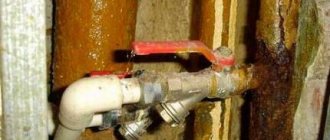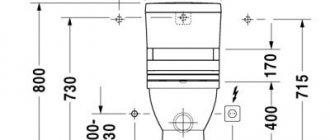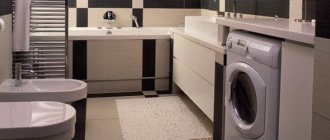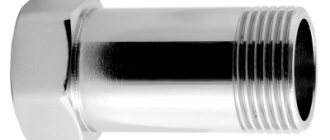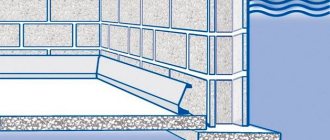Home/Water supply and sanitation/Replacement of risers in apartment buildings
Despite the fact that most residents are the owners of their apartments and pay for general building needs on a monthly basis, direct replacement of risers and other water supply elements is carried out by representatives of the management company (MC). Their actions are based on the regulatory framework of the laws of the Russian Federation. However, not many apartment owners know their rights if it is necessary to replace common communication elements located in their apartments.
The solution to replacing risers in an apartment building, the identification of responsible persons and the rules of behavior in conflict situations will be given below.
Normative base
The regulatory framework for the replacement and repair of the water supply system is regulated by:
- rules for the maintenance of property located in the common possession of the apartment building (RF RF No. 491 dated 08/13/20016);
- standards for the technical use of housing stock (Resolution of the State Construction Committee of the Russian Federation dated September 27, 2003 No. 170);
- methodological manual for the operation, maintenance and repair of housing stock MKD 2-04.2004.
Who should change risers in an apartment building?
It is a mistake to believe that if the common water risers are used by the residents of the apartments of an apartment building, then the responsibility for replacing them rests entirely with them. Ignorance of the regulatory framework of the Housing Code leads to unnecessary waste of money from the pockets of owners.
Attention
Decree of the Russian Federation No. 354, Article 149 (dated May 6, 2011) and Article 161 of the Housing Code of the Russian Federation state that repairs, as well as complete replacement of risers in an apartment building, are the responsibility of the Management Company assigned to a specific building.
Every month, each apartment owner receives a receipt for utility bills, which contains the column “maintenance and repairs.” For those funds that come from residents from paying receipts, in particular for maintenance and repairs, all preventive and repair work must be carried out.
Consequently, in the event of a pipe break or other damage to the riser, the housing office is obliged to carry out repair work without charging residents (the reverse action is illegal).
Replacement standards
According to the standards for replacing risers in an apartment building, they must be replaced in two cases:
- Expiration of the operational life of the metal structure.
- Complete renovation of the apartment's bathroom.
Living conditions provide for 2 modes of pipe replacement:
- planned - when the time for replacement has approached;
- emergency - when the integrity of the pipe has been damaged and a leak has formed.
IMPORTANT
The warranty period for pipes in apartment buildings is at least 25 years. Even if after this period the structure is intact without leaks, the riser still needs to be replaced.
Increasingly, cast iron pipes are being replaced with polypropylene ones. This is due to a number of advantages of the material:
- efficiency;
- ease;
- strength;
- environmental safety;
- resistance to deformation from thermal effects;
- resistance to corrosion and other influences;
- sliding structure of the internal walls, which prevents plaque formation;
- long service life: from 50 to 100 years.
Choosing pipes for the bathroom
Before carrying out work to replace communications in the bathroom, it is important to decide which structural elements to give preference to when installing a new system.
For wiring, as a rule, the following types of pipes are used:
- plastic;
- steel;
- cast iron;
- metal-plastic;
- ceramic;
- copper;
- asbestos-cement.
Pipes made of steel alloys (they contain various additives, aluminum, honey, nickel) are usually used in multi-story buildings where it is necessary to create efficient and durable wiring.
Such communications are resistant to hot/cold water and can withstand high pressure. Among the disadvantages are possible blockages from mineral deposits, which often accumulate on the walls.
Fragility and the formation of plugs are the negative aspects of ceramic pipelines, from which main communications are usually installed. Due to the complexity of the work, replacement of such systems is carried out by specialized organizations
Copper pipes are high-quality, durable products that are resistant to corrosion and aggressive chemicals. It is worth considering that such elements are expensive and poorly compatible with steel and other metals. Because of these disadvantages, they are most often used in private homes.
Older buildings built in the 1960s and 1970s typically used cast iron pipes. Such systems have important advantages, since this metal has good heat capacity and resistance to temperature changes.
A significant disadvantage of such structures is their heaviness (installation and disassembly requires special equipment), as well as intolerance to shock loads and a tendency to clog - accumulations of mineral deposits and debris easily form on their surface.
Currently, polypropylene pipes are widely used, which are distinguished by their affordable price, lightness, elasticity, resistance to corrosion and aggressive substances, and do not tend to form blockages.
Polypropylene pipes are suitable for laying both closed and open systems, as they are durable, aesthetically pleasing, and do not require painting or other finishing.
However, their use is justified only for laying internal communications, since plastic does not tolerate temperature changes well. In addition, polypropylene pipes are deformed when exposed to high temperatures, so they should be used with caution for hot water supply.
Another popular material today is metal-plastic, combining polymer and metal layers. This material weighs slightly more than its plastic counterparts, but is durable, resistant to mineral deposits, and most importantly, has an extremely low deformation rate.
As a rule, to carry out the work yourself, the last two options are used, since polymer and metal-plastic pipes are easy to process and install. Moreover, all work with them can be done with a minimum of special equipment.
When selecting material for replacing communications, it is also necessary to determine the dimensional parameters of the elements:
- for internal risers, pipes with a diameter of 40 mm are suitable;
- for sewer drain – 50 mm;
- for laying hot/cold water supply systems - 15, 25 and 32 mm.
The process of replacing pipes in a bathroom consists of dismantling the existing water supply and sewer systems and installing new structural elements.
An article entirely devoted to assessing the positive and negative aspects of popular positions on the market will help you compare the characteristics of PP and metal-plastic pipes.
What is included in replacing risers in an apartment building?
The process of replacing a riser in an apartment building is the direct removal of the old structure for a new one. However, this is not all that is included in the concept of “replacing a riser in an apartment building.”
Attention
First, you need to contact the management company and write an application to replace the pipe. The applicant will receive a satisfactory answer if the document is drawn up correctly and the facts supporting it do not raise doubts.
On the appointed day, representatives of the management company turn off the water in the risers and drain the remaining water. After this, craftsmen come from the management company or organization with which the management company has entered into an agreement. They carry out all the necessary procedures for replacing a faulty riser pipe in an apartment building.
- The master uses a grinder to cut out old pipes.
- Makes markings for new branches.
- New pipeline structures are being installed.
- They run water to check the tightness of all joints of the new riser.
By law, all necessary elements of the communication system that need to be replaced are delivered to the owner’s apartment. However, situations are not uncommon when the tenant himself, in whose apartment the installation is to be carried out, pays for all consumables and the element of the new pipe itself. By law, all expenses of the owner must be included in the payment of the receipt for the maintenance of common property for the next month.
Dismantling diagram
Dismantling begins by retreating 10 cm from the upper end of the pipe, and then making an incision. Stepping down 1 m from it, make another circular one, performing it in the form of a spiral. This is a precautionary measure so that the grinder disc will not jam. The worker will not be injured if the rebound occurs.
After this, take a hammer and chisel. The cut is tapped until the pipe bursts. If you do everything carefully, it will split along the cut line. If it is very rusty, it can be chipped off in parts.
When installing cast iron risers in old buildings, a caulking method was used or the pipe was fixed in a socket. Finding out how the pipe is held in place is easy. You need to hit it several times with a rubber sledgehammer, and then swing the riser.
An example of a sewerage diagram.
If you use carbolic acid, it will begin to fall out of the socket. If sulfur was used as fastening, blows with a sledgehammer will not budge it. In this case, you should take a blowtorch and start heating the pipe at the junction.
As a result of heating, the sulfur mass melts. The pipe is swung, held with pliers or an adjustable wrench, and then removed. The bell is cleaned of carbolic acid or traces of sulfur.
Sulfur fumes are poisonous, so you cannot work without a gas mask. After dismantling is completed, the room must be ventilated.
Part of the pipeline is the tee socket. It is required to connect the sewer pipe running from the kitchen to the toilet with a riser. It is most convenient to install tees made of plastic. To prevent leaks, all joints are coated with sealant.
Step-by-step instructions for replacing risers in an apartment building
A break in the water riser in one apartment requires its immediate replacement. Before carrying out repair work, the owner of an “emergency” apartment must discuss this action with the neighbors of the upper and lower floors. The fact is that the pipes are in a worn state along their entire length, despite the fact that the breakthrough occurred in a certain place. And for reliability, they should be replaced completely, in all apartments. If the neighbors disagree, the installation of a common water supply channel will be carried out only in one apartment.
The next step is to contact the Criminal Code. Their powers include shutting off the riser and draining the water. Next, complete or partial (in a separate apartment) installation of pipes takes place.
According to VSN 58-88 (r) “On the organization and implementation of reconstruction, repair and maintenance of buildings, public utility and social-cultural facilities,” planned replacement of water supply systems should be carried out every 25-30 years. Repair work is carried out inside privatized and non-privatized apartments, as well as in basements and entrances.
Replacing a sewer riser
The sewer riser belongs to the common property of the house, even though it passes through a private apartment (according to Article 290 of the Civil Code). Also, the RF PP No. 491 clause 5 dated 08/13/2006 states: “... the common property includes the drainage system, that is, the sewerage system...”.
Consequently, the management company is responsible for the installation and repair work of the sewer riser in an apartment building. For all the necessary consumables that will be required during the replacement process, as well as for the repair itself, apartment residents pay for it, paying monthly sums of money for receipts with the column “maintenance and repair of housing.”
IMPORTANT
On the day the sewer riser is replaced, the apartment owner does not have to pay anything.
But, if previously the owner of the apartment independently replaced the sewer pipe, and this fact is proven, then the owner is obliged to fully pay for the subsequent installation of this element of the communication system.
Before starting repairs to the sewer riser of an apartment building, a resident must:
- Visit the management company and leave an application for replacement of the emergency element.
- Draw up a report with a representative of the service organization, which will describe the condition of the sewer riser and (recommended) attach a photo.
- Specify the date and time of the work to be carried out, and notify neighbors about it in a timely manner.
- Determine the material of the structure that will be installed in place of the old one, as well as some nuances.
At the appointed time, repairmen come and carry out all the necessary actions to replace the sewer riser.
For your information
Upon completion, a “Certificate of Work Completed” is drawn up between the management company and the repair organization. The owner of the apartment should also keep a copy of this act.
Preparing for work
Before starting work, you need to make sure that all the necessary tools and materials are available. Here's what we need:
- pipe cutter (can be replaced with a grinder);
- perforator;
- chisel (can be replaced with a chisel) and hammer;
- a strong screwdriver, as well as a nail puller or crowbar;
- safety glasses, gloves and respirator.
Instead of cast iron, when constructing internal sewer systems, today they use a more convenient and durable material - plastic. Therefore, you need to acquire:
- pipe and tee made of PVC or polypropylene;
- pipes (with seals) for connecting plastic pipes to cast iron pipes;
- brackets for attaching the riser to the wall;
If necessary, get an inspection and 45-degree bends (allow you to move the pipe slightly).
Payment for replacement
The answer to the question regarding payment for replacing a riser in an apartment building is contained in Government Decree of the Russian Federation No. 491 dated August 13, 2006. The document determines what is common property, who is responsible for its maintenance and accordingly pays for its repair and replacement.
According to PP No. 491 and its section “Rules for maintaining the property of an apartment building,” each apartment owner pays for the maintenance and repair of all communications in the building. The same information is contained in Article 158 of the Housing Code of the Russian Federation “Expenses of owners of premises in an apartment building”: all owners of apartments in apartment buildings are involved in the costs of maintaining and repairing common property.
Thus, all costs for replacing the water supply riser in an apartment building are paid by the housing and communal services from the funds that all apartment owners contribute monthly, depositing money for receipts for the maintenance of common property.
What documents are issued to the property owner?
Upon completion of the installation of the MKD water riser pipe, a “Certificate of Work Completed” must be drawn up, which will state the following:
- date of drawing up the contract;
- serial number of the agreement according to which the act is issued;
- the volume of work performed and all actions taken;
- cost of work;
- name of the person performing the repair work;
- signatures of the contractor and the customer.
This document is made in 2 copies, one of which is given to the contractor, and the second remains with the customer. The contractor is the organization that replaces the damaged element. The customer can be the management company (in which case one copy remains with them and is not given to the owner of the apartment) or directly the owner of the property.
Even if the agreement was drawn up by a representative of the management company and the repair company, the apartment owner should make himself a copy of this act.
Is it possible to refuse to replace risers in an apartment building?
“Is it possible to refuse to replace the riser?” - a pressing question for those residents who have undergone a major renovation of the apartment, because the proposed general house procedure implies some damage to the owner’s property in the bathroom. Is it possible to write a refusal?
Based on the information contained in clause 5 of PP No. 491, risers in apartment buildings are common property. According to the law, none of the residents has the right to prevent representatives of the contractor (MC), as well as emergency services, State control and supervision authorities from inspecting the current condition of communication equipment and carrying out repair work. A control inspection should be carried out no more than once every 90 days, and in case of an emergency - at any time.
Thus, apartment owners do not have the opportunity to refuse to replace common communication systems in an apartment building. In response to the refusal, the management company or HOA has the right to sue.
Procurement of building materials
There is no ideal building material. In each case, a different option is selected that is most suitable for specific conditions.
When replacing pipelines in a toilet, you must purchase the pipes themselves, fittings and taps for them in advance. It wouldn’t hurt to design a camouflage box in advance and purchase finishing materials for it. Then all work will take a maximum of one day.
Selection of pipes for sewerage
It's easiest with sewer pipes. If the existing cast iron riser does not have cracks or holes, then it is not worth replacing. Otherwise, you should choose plastic tees and bends.
These pipe products are light in weight and easy to install. They are connected to each other in a socket with a rubber cuff. The most difficult thing is to cut such pipes with a hacksaw into a piece of the required length, not forgetting to treat the end from burrs.
Cast iron sewer parts should be separated carefully; this metal is very fragile - hitting it with a hammer or pressing a break with a large lever is prohibited
For installation in a toilet, polymer sewer pipes are sold from:
- PVC.
- Polypropylene.
- Polyethylene.
The cheapest option is polyvinyl chloride. But polyethylene and polypropylene are more resistant to household chemicals and temperature changes that occur when hot water is drained down the drain. However, in general, any of these materials is suitable for a toilet in an apartment or private house.
Previously, cast iron pipes were connected with cement or sulfur. In the first case, the joint will have to be slowly peeled apart with a screwdriver, and in the second, it will have to be heated with a torch.
One element should be removed from the other carefully by loosening it back and forth, otherwise the socket will crack and you will have to change a lot more pipes. To connect plastic and cast iron, an appropriately sized rubber cuff will be sufficient.
Types of pipes for hot water supply and cold water systems
Water pipes for replacement in the toilet can be taken:
- stainless steel;
- copper;
- polypropylene;
- polyethylene;
- polyvinyl chloride;
- metal-plastic.
Steel and copper pipes will have to be connected by welding (soldering), so they are rarely taken for self-installation. Stainless steel is often used by plumbers to replace old iron water pipe risers.
This option is the most reliable. When properly welded, the joints between new and old sections of such a pipe almost never leak.
When independently replacing toilet pipelines for hot water supply and hot water supply, it is recommended to choose plastic pipes; they are cheap and easy to connect in various ways
For cold water supply in an apartment, plastic pipes should be purchased with the PN10 marking. This thin-walled version is designed for a working pressure of 1 MPa and water temperature up to +200C. This is quite enough for HVS. For DHW you will need an analogue with PN20 and higher. It has thicker walls and higher operating parameters in terms of temperature and pressure.
PP pipes are joined by diffusion welding using fittings and butt joints. The connection is permanent. For installation of metal-plastic, compression or press fittings are used. This is the simplest material for self-assembly of a pipeline. Plus, if necessary, the water pipeline can be easily disassembled for replacement or insertion of new plumbing.
PVC is mounted on glue with a butt or fitting connection. PE (HDPE) is connected at home using electrofusion welding or compression couplings.
Metal-plastic pipes are good because they can be bent in the corners of the room; they are the most flexible of all plastic analogues. However, fittings for them will be expensive. Polypropylene water pipes are cheaper to connect, but due to the large thermal expansion, they often sag during hot water supply. PVC is cheap, but to supply hot water you will have to choose a different option.
Possible conflicts and their resolution
When replacing a riser in an apartment, its owner may encounter situations that prevent repair work . Conflict cases may be as follows:
- Refusal of the management company to replace faulty equipment.
- Neighbors disagree with replacing the riser in an apartment building.
There is no point in delaying their decision, especially if replacement of the emergency element is required in the very near future.
When contacting the management company with an application to replace the riser in an apartment building, you may encounter a refusal to carry out the work. The reasons may be different, but most often the management organization refers to the serviceability of the communication system. In this case, the owner has every right to sue the management company, as well as to recover monetary compensation from them for the damage caused.
A common emergency pipeline often leaks not only in one apartment, but also in neighbors above or below. Or the riser is in unusable condition and requires a total replacement, and not just a separate “fragment”. Therefore, installation should be carried out in several apartments. But there are often cases when some of the owners refuse to carry out the necessary work.
It is possible to solve the problem through conversations, but they do not always lead to the desired result. In this situation, the best solution would be a trial. But it is not other apartment owners who must apply to the court, but the management company. In his application to the judicial authorities, the representative of the management company puts forward a demand to the court to force the owner to replace the riser.
For your information
Litigation is not a quick process, but it is effective. According to his decision, the owner obstructing the repair undertakes not only to allow repairmen to replace the pipe, but also to install the concealing box (if there is one). The judge can significantly speed up the process of the case by satisfying the plaintiff’s request in accordance with Art. 212 of the Civil Procedure Code.
Selection of pipe laying system
The pipeline can be installed in different ways. The system can be open when the networks are laid directly along the walls. In this case, access to the pipes is easier, but the appearance spoils the interior of the bathroom.
Before replacing pipes in the bathroom, it is necessary to draw up a diagram of the planned placement of communications, indicating connections to all plumbing fixtures
The option with closed communications looks more aesthetically pleasing. In this case, grooves are made in the walls - special grooves where structural elements are hidden, which are then sealed with plaster and finishing materials.
The closed method is quite expensive, in addition, it can only be recommended for the most reliable pipes and carefully made connections, since access to the pipes is very difficult
Nowadays, for laying pipes, a masking method is often used, which does not require much trouble. In this case, when laying structures, they are hidden under plumbing fixtures, interior items, or hidden in boxes specially constructed to protect and decorate communications.
Complaint about poor quality replacement of risers in an apartment building
If the emergency riser is replaced poorly, the apartment owner has the right to file a complaint against the organization responsible for this matter. The complaint is submitted in writing to the State Housing Inspectorate of a specific region of Russia. It indicates the name and address of the owner where the emergency water riser is located.
The complaint consists of a statement and a request. The application must refer to Art. 161 of the Housing Code of the Russian Federation “General requirements for the management of an apartment building” and indicate that the repair work did not eliminate the emergency situation. The petition contains the applicant’s request to oblige the management company to correct the problems in accordance with the standards.
It would not be amiss to attach to the complaint photographic materials proving poor quality work, as well as an act drawn up between the tenant and the management company.
Installation of a new pipeline
The choice of the type of pipeline installation is made exclusively by the homeowner himself.
Selection of pipe laying system
Each type of wiring has different features, advantages and disadvantages, but does not in any way determine the type of room. You can choose any layout scheme.
Necessary tools and consumables
When solving the problem of how to replace pipes with your own hands, prepare the following tool:
- hacksaw for metal;
- special scissors for metal-plastic products;
- open-end wrenches, gas, adjustable;
- a hammer drill or drill for drilling holes for anchor holders;
- sealant - tow, fum tape, plumbing flax, sealant (paste or glue);
- silicone gaskets;
- special soldering iron for soldering pipes;
- marker;
- tape measure for measurements.
To replace pipes, you need a hacksaw.
There are 3 types of consumables: straight, angled and tees. They may have the same or different type of thread - external or internal. The first one is needed for installing valves. The second is for connecting parts together.
Pipe installation instructions
To install the pipeline correctly, you need to follow simple rules and carry out the work consistently. It is easy to connect pipes, but it is difficult to ensure that there are no leaks at the joints.
It is recommended to perform installation according to the following algorithm:
- Markers are placed on the walls, which are the approximate locations for placing faucets and other water sources.
- Pieces of products are measured with a tape measure. Then the material is cut with scissors or sawed with a hacksaw.
- Depending on the type of wiring, soldering or connection with fittings is carried out.
- There is a connection to the consumer system - cistern, toilet, bathtub, sink, etc.
- The reliability of connections and sealing of the structure is checked by supplying water to it.
- The pipeline is attached to the walls using anchor holders.
- An additional check is carried out, because During installation, parts are subjected to physical stress.
Pipeline pressure testing
Air pressure testing means supplying it to a closed water supply system. It is carried out with the aim of applying pressure several times higher than natural during operation. If the system passes this test, then it is considered suitable for further use. The procedure allows you to identify areas that may soon develop leaks and eliminate holes or cracks.
Pressure testing of the pipeline is carried out in order to supply high pressure.
To do this, use a special pump or a circulation pump, which is part of the autonomous heating system. Pressure testing is carried out with both air and water. More often - the first, since liquid can get outside the system.
The procedure must be performed by a certified employee. Completion of pressure testing by a specialist is accompanied by the preparation and signing of a water supply testing report.
Crimping is necessary in the following cases:
- at enterprises where a complex water supply system is installed;
- before first commissioning;
- after repairing the system or replacing its part;
- after idle time without use.
Also, crimping is part of a routine inspection of some pipelines and sewers consisting of polymer parts. It is also carried out after flushing the system if aggressive chemicals were used. They can weaken the walls of plastic products and cause leaks at the joints.
Cleaning with chemicals also poses the risk of leaks. Therefore, pressure testing should be carried out as planned for sewage drains.
System health check
Functional testing without pressure testing is carried out from the riser to the end of the system. In this case, you should pay attention to checking:
- Joints on pipelines and sewers.
- Tightness when supplying hot water.
- Correct and reliable installation of plumbing fixtures - sinks, toilets, hoses, metering devices.
- Pressure in the system - whether it became clogged during installation.
The system's functionality is checked from the riser to the end of the system.
At first, it is recommended to keep the taps closed to determine the tightness at the joints, and then open them one by one.
It is worth making sure that the sewerage and pipeline are designed in accordance with the project. Each element of the system must be in the place indicated in the plan.
Installed devices must be cleaned of debris. There should be no deflections or subsidence in the places where metering equipment is installed or in the spans between joints.
It is better to use pressure testing with water, since the high pressure liquid will wash away the remaining construction debris in the system. This is especially true for high vertical areas. If you find a leak or weak seal, fix the problem and recheck.
